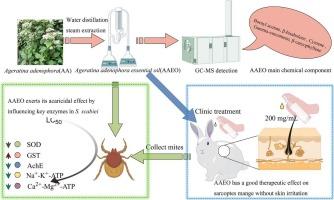Ageratina adenophora essential oil: A promising miticidal agent against Sarcoptes scabiei, and its effects on key enzymatic pathways
IF 3.4
2区 农林科学
Q2 BIOTECHNOLOGY & APPLIED MICROBIOLOGY
引用次数: 0
Abstract
The common scabies mite, Sarcoptes scabiei (S. scabiei) is a cosmopolitan parasite of humans and other mammals. This study evaluated the potential of Ageratina adenophora (A. adenophora) essential oil (EO) to serve as a synergist for enhancing biological control agents against scabies by investigating its acaricidal activity and underlying mechanism. 52 components (99.6 %) were identified by GC–MS. The major components included bornyl acetate (11.16 %), β-bisabolene (9.34 %), cymene (8.17 %), γ-curcumene (8.10 %), and β-caryophyllene (8.05 %). In vitro, it showed good contact toxicity, fumigation activity, and repellency against S. scabiei. At 40 mg/mL for 2 h, the contact mortality, fumigation mortality and repellent rates were 100 %, 100 %, and 92 %, respectively. Medium lethal concentration (LC50) values for contact toxicity and fumigation activity at 2 h were 27.132 mg/mL and 12.579 mg/mL. In vivo, cure rates at 20, 10, 5 mg/mL were 100 %, 100 %, 83.3 % in rabbits, with no skin irritation at 200 mg/mL. Enzyme tests showed that SOD increased first, then decreased, GST was activated, AchE, Na+-K+-ATP, and Ca2+-Mg2+-ATP were inhibited. The significant activity of A. adenophora essential oil both in vitro and in vivo, along with its ability to disrupt key physiological processes in mites, supports its potential as a synergist to enhance the efficacy of biological control agents against scabies mites. Additionally, the observed safety profile at certain doses further encourages its exploration as a component within integrated pest management strategies.

一种有前途的杀螨剂——腺参精油及其对关键酶途径的影响
常见的疥疮螨,疥螨(S.疥螨)是一种世界性的寄生虫,人类和其他哺乳动物。本研究通过对腺孢Ageratina adenophora (a . adenophora)精油的杀螨活性及其作用机制的研究,评价了其作为生物防治疥疮增效剂的潜力。GC-MS共鉴定出52种成分(99.6%)。主要成分为醋酸龙脑酯(11.16%)、β-双abolene(9.34%)、伞花素(8.17%)、γ-姜黄烯(8.10%)和β-石竹烯(8.05%)。体外实验结果表明,该制剂对疥螨具有良好的接触毒性、熏蒸活性和驱避作用。在40 mg/mL处理2 h时,接触死亡率为100%,熏蒸死亡率为100%,驱避率为92%。接触毒性和熏蒸活性2 h的中致死浓度(LC50)分别为27.132 mg/mL和12.579 mg/mL。在家兔体内,20mg /mL、10mg /mL、5mg /mL治愈率分别为100%、100%、83.3%,200mg /mL对皮肤无刺激。酶检测结果显示SOD先升高后降低,GST被激活,AchE、Na+-K+-ATP、Ca2+-Mg2+-ATP被抑制。腺槐树精油在体外和体内的显著活性,以及其破坏螨虫关键生理过程的能力,支持其作为增效剂的潜力,以增强生物防治剂对疥螨的功效。此外,在某些剂量下观察到的安全情况进一步鼓励探索将其作为虫害综合管理战略的组成部分。
本文章由计算机程序翻译,如有差异,请以英文原文为准。
求助全文
约1分钟内获得全文
求助全文
来源期刊

Biological Control
生物-昆虫学
CiteScore
7.40
自引率
7.10%
发文量
220
审稿时长
63 days
期刊介绍:
Biological control is an environmentally sound and effective means of reducing or mitigating pests and pest effects through the use of natural enemies. The aim of Biological Control is to promote this science and technology through publication of original research articles and reviews of research and theory. The journal devotes a section to reports on biotechnologies dealing with the elucidation and use of genes or gene products for the enhancement of biological control agents.
The journal encompasses biological control of viral, microbial, nematode, insect, mite, weed, and vertebrate pests in agriculture, aquatic, forest, natural resource, stored product, and urban environments. Biological control of arthropod pests of human and domestic animals is also included. Ecological, molecular, and biotechnological approaches to the understanding of biological control are welcome.
 求助内容:
求助内容: 应助结果提醒方式:
应助结果提醒方式:


